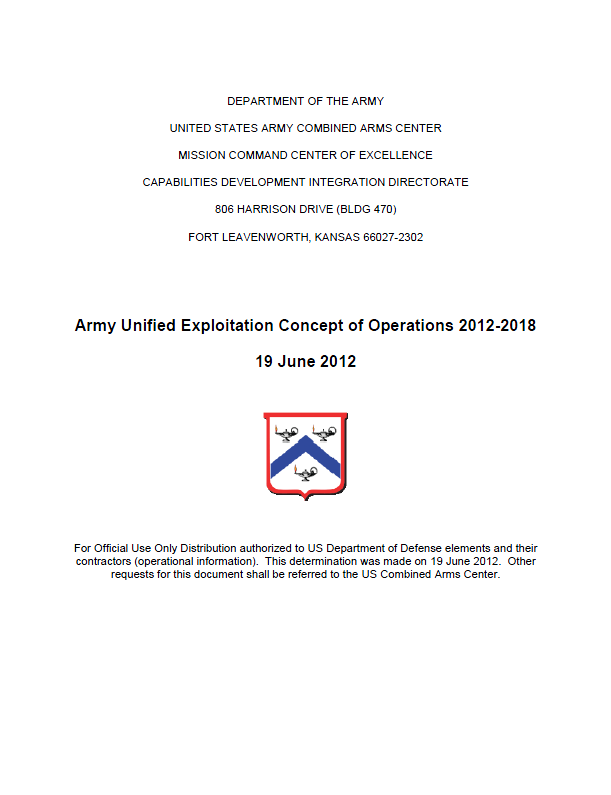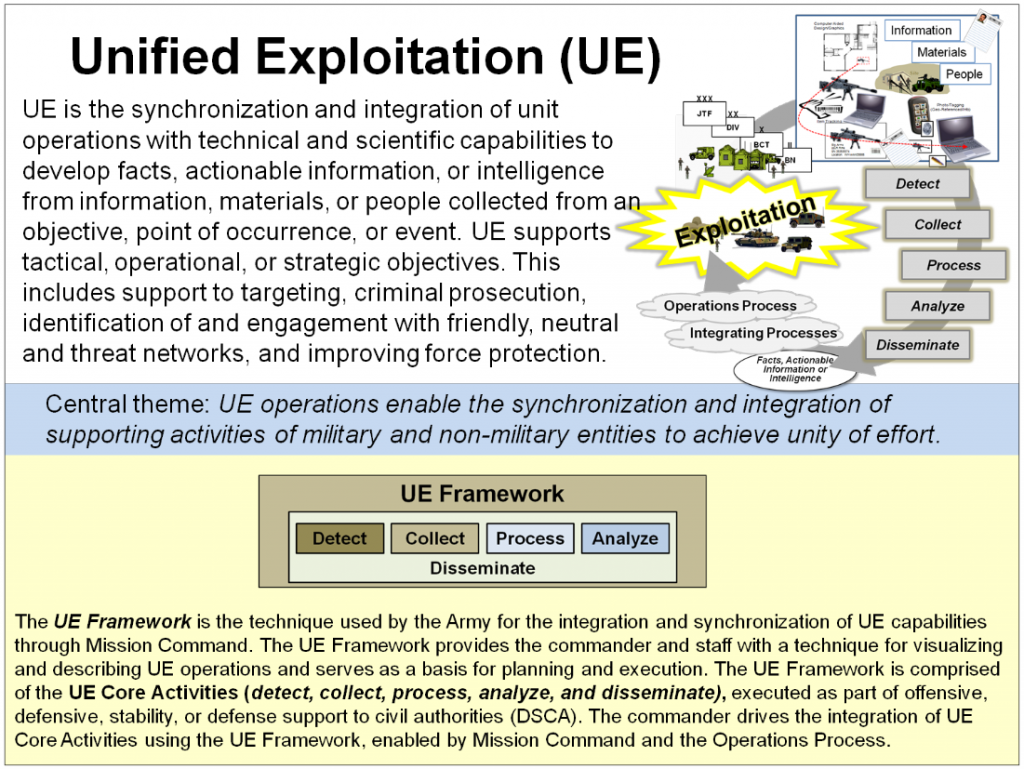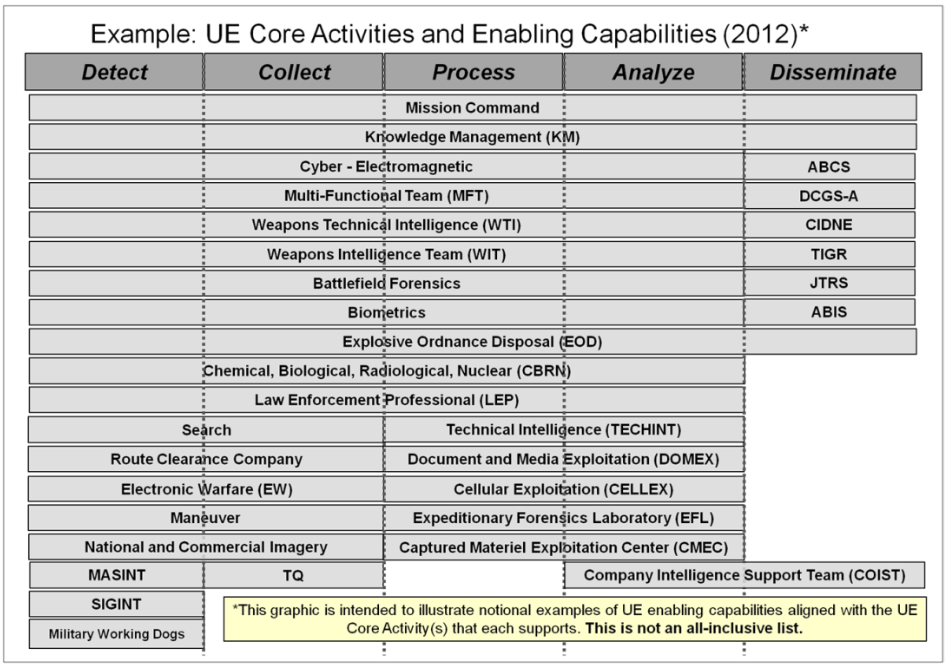UNITED STATES ARMY COMBINED ARMS CENTER MISSION COMMAND CENTER OF EXCELLENCE
- 98 pages
- For Official Use Only
- June 19, 2012
- 4.9 MB
Development of the Army Exploitation Concept of Operations (AEC) was directed by Headquarters, Department of the Army Execution Order 268-11, dated 23 August 2011. This document is designed to address the Army’s lack of a “systems approach” to effectively integrate multiple organizations, disciplines, functions, and processes that support exploitation through their application of tactical, technical, and scientific capabilities.
This CONOPS describes an overarching concept of operations for the 2012-2018 timeframe that provides a framework for “Unified Exploitation (UE)” operations and the basis to develop supporting capabilities. It establishes linkages to other Army concepts and describes how UE enables decisive action in support of unified land operations. This CONOPS describes the operational context and how commanders integrate supporting UE capabilities through Mission Command to produce an operational advantage. This CONOPS addresses the central military problem: the Army lacks a systematic approach to effectively integrate multiple organizations, disciplines, functions, and processes that support exploitation through their application of tactical, technical, and scientific capabilities. The absence of an organized exploitation framework to develop facts, actionable information or intelligence from collected enemy information, materials, or people, results in a knowledge void. This lack of knowledge may compromise our ability to execute commander directed, follow-on actions and represents tactical and perhaps even strategic opportunities lost.
Unified Exploitation (UE) is the synchronization and integration of unit operations with technical and scientific capabilities to develop facts, actionable information, or intelligence from information, materials, or people collected from an objective, point of occurrence, or event. UE supports tactical, operational, or strategic objectives. This includes support to targeting, criminal prosecution, identification of and engagement with friendly, neutral and threat networks and improving force protection. It is complementary rather than additive in the employment of supporting capabilities from different warfighting functions. UE provides the Army with an enterprise approach. The UE Framework provides commanders and staffs with a technique and basic conceptual structure for visualizing and describing UE operations. The UE Framework consists of the five UE Core Activities: detect, collect, process, analyze, and disseminate.
This CONOPS is consistent with The Army Capstone Concept (ACC), TRADOC Pam 525-3-0. UE supports operational adaptability and enhances the Army’s ability to understand the situation in breadth, depth, and context. It is also consistent with The Army Operating Concept (AOC), TRADOC Pam 525-3-1. UE enhances the Army’s ability to interdict the enemy decision cycle and act faster than the enemy. The Army Functional Concepts (AFC) describe how Army forces, as part of unified action, exercise the six Army warfighting functions. The Army conducts UE, supported by the capabilities resident across the six warfighting functions.
An integrated UE enterprise provides the Joint Force Commander with synchronized and integrated capabilities that support unified land operations as part of unified action. To ensure success, UE is an enduring capability enabled through doctrine, organization, training, material leadership and education, personnel, and facilities (DOTMLPF) and institutionalized with other Army capabilities in the 2012-2018 timeframe. UE is nested within Army capstone guidance and UE capabilities are methodically assessed and developed through the Joint Capabilities Integration Development System (JCIDS) process. Each Army warfighting function implements UE through an enterprise infrastructure that is adaptable to their unique requirements.
…
Unified Exploitation (UE) is the synchronization and integration of unit operations with technical and scientific capabilities to develop facts, actionable information, or intelligence from information, materials, or people collected from an objective, point of occurrence, or event. UE supports tactical, operational, or strategic objectives. This includes support to targeting, criminal prosecution, identification of and engagement with friendly, neutral and threat networks, and improving force protection.
UE enables friendly forces to interdict the enemy decision cycle. Enabled by Mission Command:
- UE supports the understanding of the Operational Environment (OE) required by the commander to successfully execute decisive action
- UE achieves synergy across the warfighting functions.
- UE is complementary rather than additive in the employment of supporting capabilities.
- UE supporting capabilities employ their own set of approved processes, integrated and synchronized through the UE Framework
- Each capability enhances the effectiveness and compensates for the shortfalls of the others
- UE achieves an effect on the enemy that is greater than if the supporting capabilities are used individually or in sequence
UE Operations enable unified action, the organization, synchronization, coordination, and integration of supporting activities of military and non-military entities, to achieve unity of effort.
1-1 PurposeThis document describes an overarching concept in the 2012-2018 timeframe that provides a framework for UE operations and the basis to develop supporting capabilities. It establishes linkages to other Army concepts and describes how UE is an enabler to decisive action in support of unified land operations. This CONOPS describes the operational context, military problem, and how commanders integrate supporting UE capabilities using Mission Command to produce an operational advantage.
1-2 Background
The term “Sensitive Site Exploitation” (SSE) emerged during Operation Iraqi Freedom (OIF). SSE was associated with the efforts to collect information on Iraqi weapons of mass destruction (WMD) programs. As OIF matured, the operational force used the term SSE to describe any operation whose purpose was to search for and collect enemy information, material, and people. Army schools and centers developed new training and doctrine to meet the demands of the operational force, but without integration and synchronization, resulting in ambiguous if not conflicting terms such as Site Exploitation (SE), Tactical Site Exploitation (TSE), and Military Search. Army organizations used all of these terms to describe exploitation actions executed in relationship to combating IEDs, targeting insurgent networks, and support to host nation (HN) rule of law.
As Operation Enduring Freedom (OEF) and OIF progressed, Army, Joint, and Coalition forces established ad hoc capabilities (Task Force Troy, Task Force Paladin, the Combined Explosive Exploitation Cell (CEXC), etc.) to meet tactical and operational requirements for more sophisticated analysis of collected information, materials, and people. In 2007 the Asymmetric Warfare Group (AWG) observed that the BCT’s ability to effectively understand, visualize, and target irregular forces in complex environments was immature and highly dependent on integrating unique, unfamiliar, and non-organic capabilities/enablers at the BCT level. AWG recognized that pre-deployment training did not adequately develop the agility, responsiveness and proficiency necessary for BCTs to capitalize on fleeting opportunities to attack threat networks or enable friendly networks in a counterinsurgency. In response AWG developed “Focused Operations Training” to partially mitigate capability gaps. In 2010, BCTs deployed to Afghanistan task organized “Focused Targeting Forces” or FTFs from organic and assigned assets. These specialized organizations were composed of maneuver elements, Multi-Functional Teams (MFT), HUMINT and SIGINT assets along with interpreters and Female Engagement Teams (FET). The FTFs were tasked with the planning, preparation and execution of site exploitation operations in the BCT’s prescribed area of operation. In 2010, the Army published ATTP 3-90.15, Site Exploitation Operations, to fill a need for supporting doctrine. Army Schools and Centers of Excellence unilaterally developed related capabilities to support the needs of the deployed force. Although beneficial, these efforts suffered from a lack of a unifying and integrating framework. Furthermore, the lack of a clearly defined military problem resulted in multiple asynchronous DOTMLPF solutions, developed in relative isolation and without complete integration.
In 2011, the Army recognized the need for a central unifying concept to assist commanders in achieving unity of effort for the synchronized application of tactical, technical, and scientific capabilities. The adjective “site” was dropped in an effort to convey that these activities transcended the physical location and an overarching concept known as “Exploitation” emerged. In 2011, the Commander, US Army Combined Arms Center, approved the term “Unified Exploitation” to distinguish it from the offensive task described in FM 3-90, Tactics, and with similar activities containing the word “exploitation”.
…



